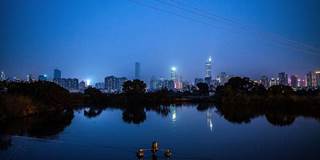The Promise of China’s Pearl River Delta
July 1 will mark the 20th anniversary of Hong Kong’s return to China, after more than 100 years of British colonial rule. It's an ideal moment to highlight the role of China's "city clusters," particularly the Pearl River Delta – which includes Hong Kong, Macau, and Guangdong province – in advancing the country's development.
HONG KONG – July 1, 2017, will mark the 20th anniversary of Hong Kong’s return to China, after more than a century of British colonial rule. It comes at a moment when China’s leaders are increasingly promoting Hong Kong’s unique role in advancing the country’s economic development.
Two months ago, Premier Li Keqiang described China’s intention to deepen economic cooperation across the Guangdong-Hong Kong-Macau Bay Area – which Hong Kong analysts have called the Pearl River Delta (PRD) – in order to reinforce its role as a major driver of sustainable development. The region includes Guangdong’s nine key cities – including Guangzhou, Foshan, and Shenzhen – plus Hong Kong and Macau. Last year, the PRD’s population stood at 68 million, and its GDP was $1.3 trillion.
The PRD is the southern pillar of the three Chinese coastal growth clusters. In the middle is the Yangzi River Delta (YRD), which includes Shanghai, has a population of 130 million and GDP of $2 trillion. To the north is the Beijing/Tianjin/Bohai (BTB) corridor, covering ten key cities; it has a population of 100 million and GDP of $1.3 trillion. Taken together, these three clusters account for 21% of China’s population and just under 40% of its GDP.



HONG KONG – July 1, 2017, will mark the 20th anniversary of Hong Kong’s return to China, after more than a century of British colonial rule. It comes at a moment when China’s leaders are increasingly promoting Hong Kong’s unique role in advancing the country’s economic development.
Two months ago, Premier Li Keqiang described China’s intention to deepen economic cooperation across the Guangdong-Hong Kong-Macau Bay Area – which Hong Kong analysts have called the Pearl River Delta (PRD) – in order to reinforce its role as a major driver of sustainable development. The region includes Guangdong’s nine key cities – including Guangzhou, Foshan, and Shenzhen – plus Hong Kong and Macau. Last year, the PRD’s population stood at 68 million, and its GDP was $1.3 trillion.
The PRD is the southern pillar of the three Chinese coastal growth clusters. In the middle is the Yangzi River Delta (YRD), which includes Shanghai, has a population of 130 million and GDP of $2 trillion. To the north is the Beijing/Tianjin/Bohai (BTB) corridor, covering ten key cities; it has a population of 100 million and GDP of $1.3 trillion. Taken together, these three clusters account for 21% of China’s population and just under 40% of its GDP.